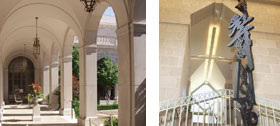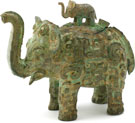
Above: Four lidded ritual wine ewers (guang).
Treasures of Ancient Chinese Art Return to Public View at the Freer
Renowned Collections of Jades and Bronzes Come to Light in Newly Renovated Galleries
Media only: Megan Krefting 202-633-0271; kreftingm@si.edu
Public only: 202.633.1000
September 30, 2010
Ancient jades and bronzes widely considered to be among the greatest treasures of Chinese art will return to public view at the Smithsonian’s Freer Gallery of Art Nov. 20. More than 100 works will be reinstalled in two newly renovated galleries after more than a decade in storage.
Chinese jade carvings and vessels cast from bronze are some of the oldest and most aesthetically and technically accomplished works of art ever created. In the early 20th century, guided by personal taste and self-taught connoisseurship, Charles Lang Freer amassed a large number of Chinese objects that over time have come to epitomize the classic periods of Chinese art history.
The reinstallation of galleries 18 (Bronzes) and 19 (Jades) represents the first phase of a three-year plan to reimagine the Freer’s entire suite of six Chinese galleries. The goal is to showcase major collections in redesigned spaces that reflect the founder’s original focus on aesthetics and comparative study.
“Above all, we hope the return of the jades and bronzes will offer an invitation to our visitors to look closely and appreciate the quality and character of these extraordinary objects,” said Keith Wilson, associate director and curator of ancient Chinese art. “It is not an exaggeration to say that these collections represent some of the greatest moments in the history of Chinese art.”
Gallery 18: Ancient Chinese Bronzes
The Freer Gallery of Art possesses one of the finest and largest collections of ancient Chinese bronzes outside China. Representing all periods of the Bronze Age, the collection is particularly rich in products from metropolitan foundries of the late Shang (ca. 1500-1050 BCE) and early Western Zhou (ca. 1050-900 BCE) dynasties. The new installation will feature some 40 Shang and early Zhou examples. These objects, among the most important for early Bronze Age society, originally functioned as containers for food and wine offered to deceased ancestors in solemn ritual banquets. The installation invites viewers to appreciate early Chinese bronze casting, the function of various vessel forms and the evolution of decorative motifs, primarily animals, both real and imagined. This initial focus on early bronzes will be followed in 2012 with an installation dedicated to the later Bronze Age vessels and furnishings in the gallery’s collection.
Gallery 19: Ancient Chinese Jades
Charles Lang Freer assembled a truly remarkable collection of ancient jades, with a noteworthy focus on pieces produced by the late Neolithic Liangzhu culture (ca. 3300-2250 BCE), now viewed as one of the most important and influential civilizations in Chinese antiquity. The Liangzhu people created artistically and technically sophisticated jades in the form of personal ornaments, ceremonial axes, ritual disks and tubes that were sometimes adorned with beautiful surface decoration and important inscriptions.
Gallery 19 will feature 80 works illustrating the achievements of jade production, including a large and intriguing group of jade disks from the Liangzhu and later cultures. These mysterious objects seem to have played an important role in burial rites, since they are frequently found in tombs. Three of the earliest disks on display, from Liangzhu, exhibit pictorial inscriptions combining a standing bird with signs for the sun and moon. Such designs, precursors to Chinese writing, are extremely rare and probably signify clan ownership.
The disks are joined by a group of ceremonial tools and weapons as well as later luxuries that illustrate the enduring influence of craft and design first developed during the Neolithic period.
Focus on China Extends to Upcoming Exhibitions
The reinstallation project is part of a larger constellation of China-focused projects that will include several major exhibitions in the Sackler in the coming years. On Feb. 26, 2011, the Sackler will present “Echoes of the Past: The Buddhist Cave Temples of Xiangtangshan,” a major traveling exhibition featuring sixth-century Chinese sculpture and 3-D imaging technology to explore one of the most important Buddhist devotional sites in early medieval China. From Sept. 24, 2011, through Jan. 29, 2012, the Sackler will offer “Photographs of the Empress Dowager Cixi – 1903 to 1905,” which will feature large-scale prints based on the galleries’ collection of vintage glass-plate negatives. The galleries’ extensive collection of Chinese ancestor portraits will be featured in a spring 2011 exhibition, designed to complement the Empress Dowager show. In March 2012, “Shipwrecked: Tang Treasures from the Java Sea” will showcase the astonishing ninth-century gold, silver and ceramics recovered from one of the most important marine archaeological discoveries of the 20th century.
The China Gallery project was made possible with the support of Thaw Charitable Trust, John and Julia Curtis, Jane and Leopold Swergold, Mr. and Mrs. Hart Fessenden, Mr. and Mrs. Michael Feng, Peggy and Richard M. Danziger, the Sylvia and Alexander Hassan Family Foundation Inc. and other supporters.
For more information about the Freer and Sackler galleries and their exhibitions, programs and other events, the public may visit www.asia.si.edu. The Freer Gallery of Art, located at 12th Street and Independence Avenue S.W., and the adjacent Arthur M. Sackler Gallery, located at 1050 Independence Avenue S.W., are on the National Mall in Washington, D.C. Hours are 10 a.m. to 5:30 p.m. every day except Dec. 25, and admission is free. The galleries are located near the Smithsonian Metrorail station on the Blue and Orange lines. For general Smithsonian information, the public may call (202) 633-1000 or TTY (202) 633-5285.

Exhibition Information
Ancient Chinese Jades and Bronzes
Opens November 20, 2010
Freer Gallery of Art
Contact us
pressasia@si.eduTel: 202.633.0271
Fax: 202.633.0046
Office of Marketing and Communications
Freer Gallery of Art and Arthur M. Sackler Gallery
PO Box 37012, MRC 707
Washington, DC 20013-7012
